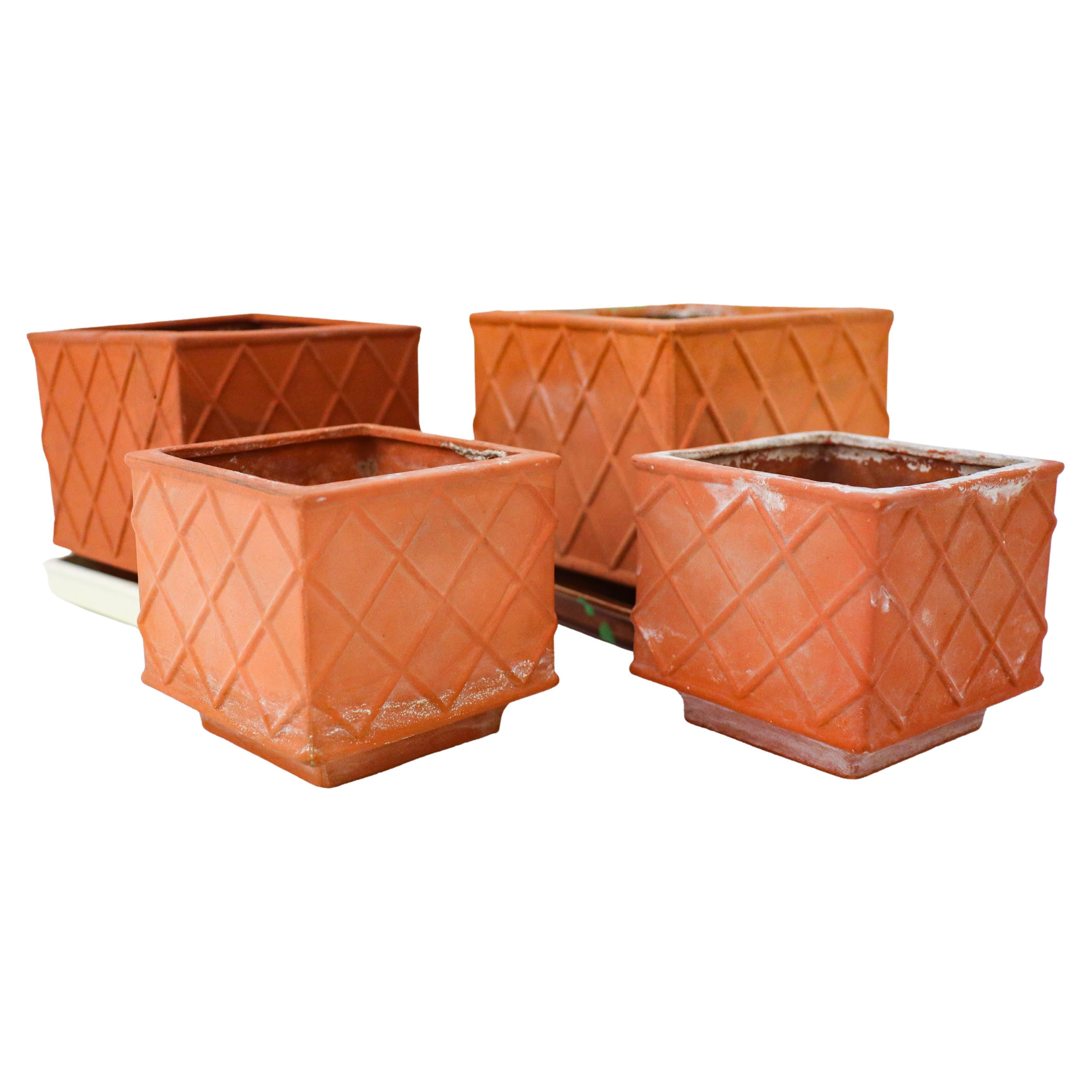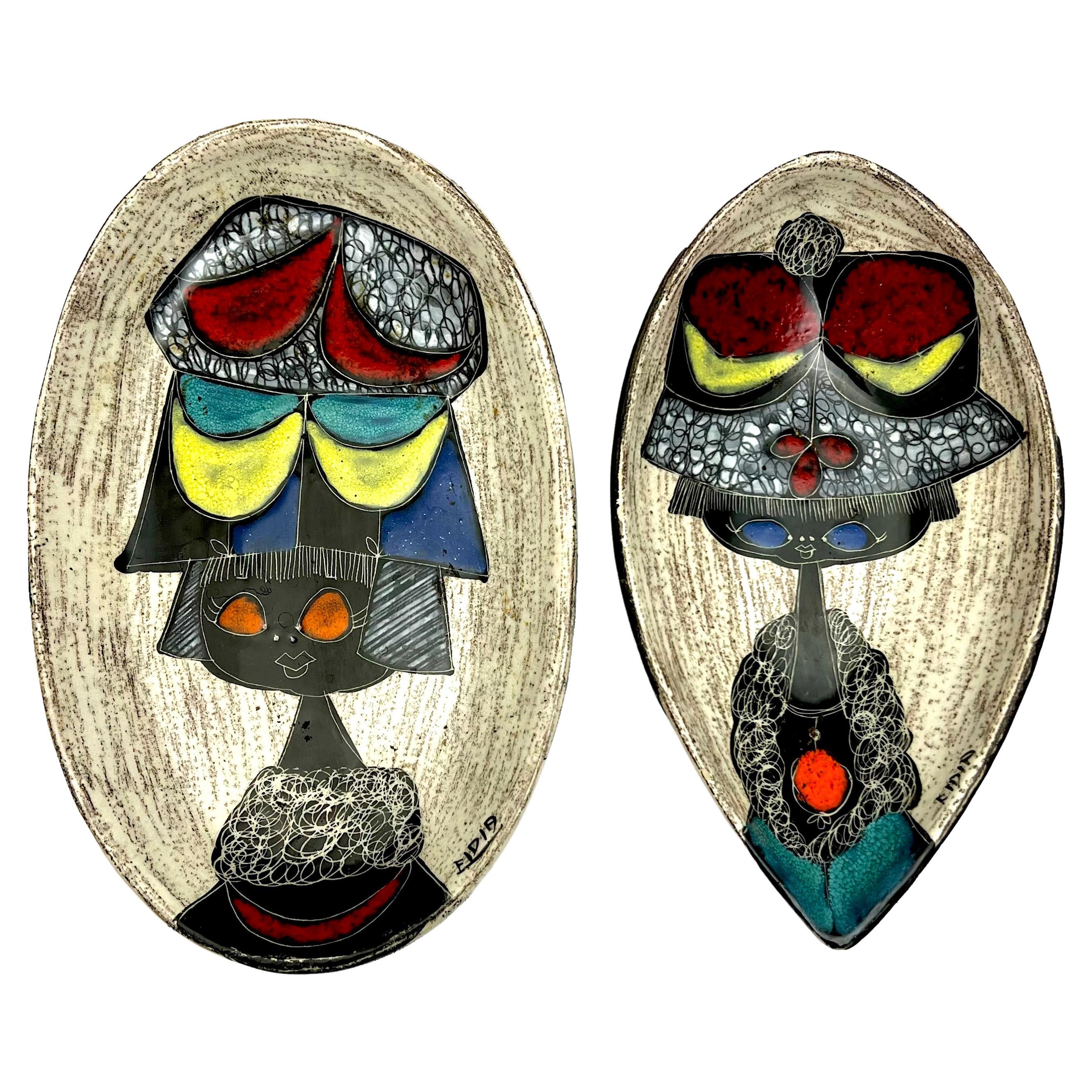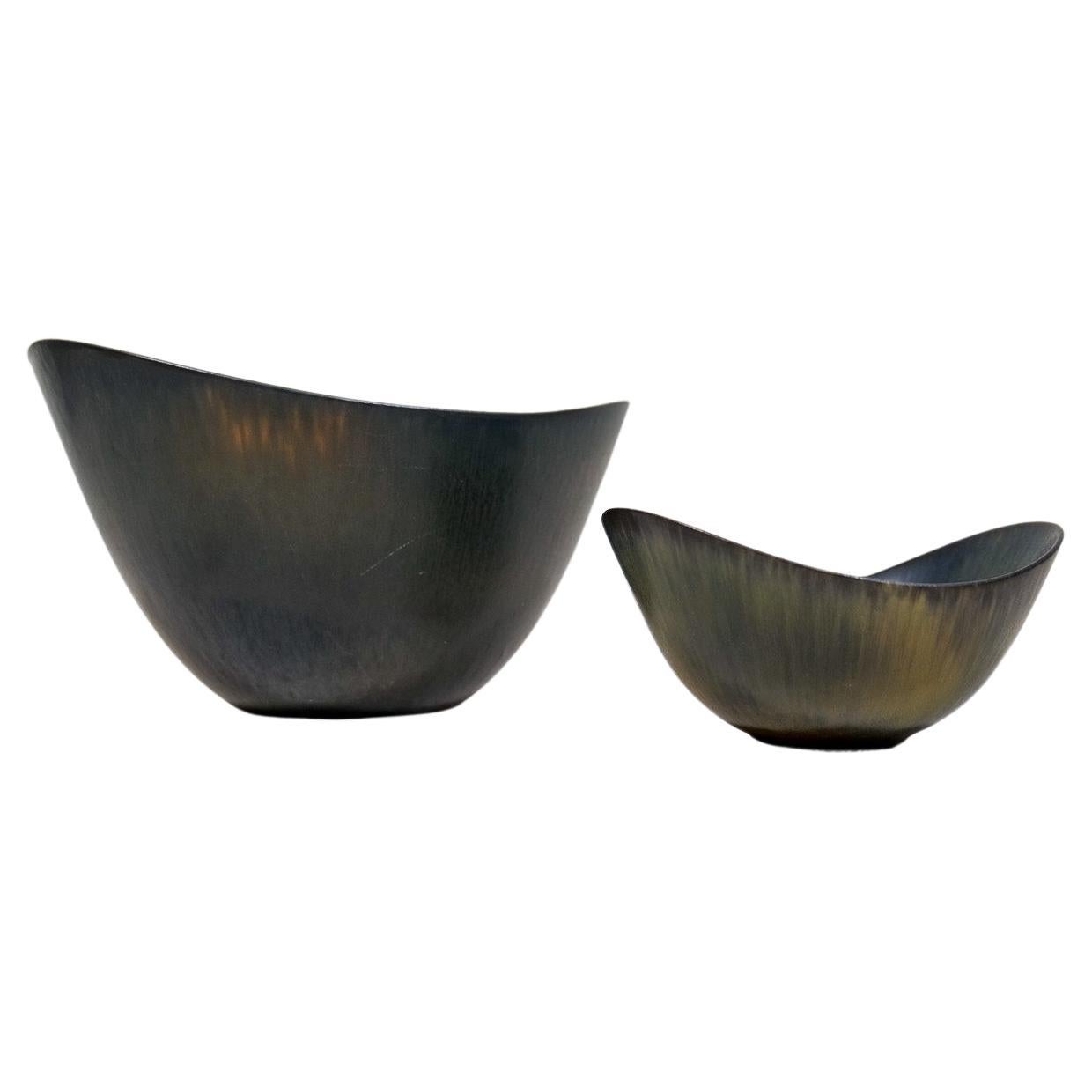Items Similar to Pair of Glistening Cachepots Planters
Want more images or videos?
Request additional images or videos from the seller
1 of 7
Pair of Glistening Cachepots Planters
About the Item
Two eye-catching Italian cachepots, planters, or beautiful accessory pottery having a glamorous gilded glaze and handles.
- Dimensions:Height: 7.75 in (19.69 cm)Width: 9.5 in (24.13 cm)Depth: 7 in (17.78 cm)
- Sold As:Set of 2
- Materials and Techniques:
- Place of Origin:
- Period:
- Date of Manufacture:1960
- Condition:
- Seller Location:Hopewell, NJ
- Reference Number:1stDibs: LU91988972821
About the Seller
4.8
Gold Seller
These expertly vetted sellers are highly rated and consistently exceed customer expectations.
Established in 2008
1stDibs seller since 2011
2,093 sales on 1stDibs
Typical response time: 2 hours
- ShippingRetrieving quote...Ships From: Hopewell, NJ
- Return PolicyA return for this item may be initiated within 3 days of delivery.
More From This SellerView All
- Glistening Pair of Small Italian Lusterware Compotes UrnsLocated in Hopewell, NJLovely pair of compotes with urn shape and curved handles, having gorgeous white, gold and navy blue intricate pattern.Category
Vintage 1960s Italian Ceramics
- Glistening Bucquet Rippled Glass Bowl with Copper and Gilded Turtle DecorationBy George BucquetLocated in Hopewell, NJSwimming at the bottom of a glistening rippled glass bowl is a copper and gold leaf turtle. Signed on underside by artist. George Bucquet uses a process of pouring hot glass, thick a...Category
1990s American Decorative Bowls
MaterialsArt Glass
- Charming Antique French Wire Basket Planter with Decorative Tole LeavesLocated in Hopewell, NJWonderful tabletop accessory that's a 19th century wire and metal basket planter, filled with tole leaves in a gunmetal grey.Category
Antique 19th Century French Decorative Baskets
MaterialsMetal
- Sunny Pair of Portuguese Temple Jars Lidded UrnsLocated in Hopewell, NJTwo beautiful lidded temple jars or vessels having a wonderful yellow and white glaze. Marked made in Portugal on the bottom.Category
Vintage 1960s Portuguese Ceramics
MaterialsCeramic
- Glistening pair of Antique Bruce Crane Landscape PaintingsLocated in Hopewell, NJBruce Crane pair of American impressionist landscape paintings in gilt frames. Signed lower left. With frame: 13.25” X 11” H Just painting: 7.5” X 5.25”. Bruce (Robert Bruce) Cra...Category
Early 20th Century American Arts and Crafts Paintings
MaterialsCanvas, Giltwood
- Set of French Art Nouveau Pair of Vases and Matching Jardiniere TureenLocated in Hopewell, NJLovely set of French Art Nouveau pottery consisting of a pair of vases and a matching soup tureen or jardiniere. Ivory roses adorn the top of the vases and the tureen. Beautiful ivor...Category
Antique Early 1900s French Art Nouveau Ceramics
MaterialsPottery
You May Also Like
- Four Planters by Wilhelm Kåge, 1950s Gustavsberg, Scandinavian DesignBy Gustavsberg, Wilhelm KageLocated in Stockholm, SEFour planters with two dishes of model Planta designed by Wilhelm Kåge ay Gustavsberg. The larger once are 13 x 13 cm and 11 cm high (5.2" x 5.2" x 4.4")...Category
Antique Mid-19th Century Swedish Scandinavian Modern Decorative Bowls
MaterialsPorcelain
- Two Pairs of Italian Maiolica Baskets, circa 1780By Antonio FerrettiLocated in Milano, ITTwo pairs of maiolica baskets Antonio Ferretti Manufacture Lodi, circa 1770-1790 Maiolica polychrome decorated “a piccolo fuoco” (third fire). Measures: A) Height 3.54 x 6.69 x 9.84 in (9 x 17 x 25 cm); B) Height 3.93 x 7.48 x 11.02 in (10 x 19 x 28 cm). Total weight 4.85 lb (2.200 kg) State of conservation: A) One of the smaller baskets has some areas of restoration, the other slight chipping from use; B) One of the larger baskets is intact and the other shows a clearly glued break. The mold with which the baskets were forged simulates a wicker weave. The two larger works have high, vertical walls, with branch-shaped handles penetrating the weave. The painted decorations, small polychrome flowers applied only externally, highlight the points where the weaves intersect. The decision to leave the center of the basket devoid of decoration is highly unusual, but given the size and complexity of the shape, as well as the quality of the enamel, it is possible to hypothesize that it represents a precise choice in manufacturing or for a particular client. The two smaller baskets have small, twisted handles and, on the outside, reproduce more decisively the characteristic wicker weave, obtained through thin molded lines. The interior exhibits a rich, typical decoration of naturalistic flowers: a bunch centered around a main flower and secondary stems accompanied by small “semis”. The exterior of these works is also adorned with small little flowers where the weaves intersect. The size and morphological characteristics of the baskets confirm their attribution to the Lodi factory of Antonio Ferretti between 1770 and 1790, during its most successful period; by this point his original reworking of the "Strasbourg" decoration, known as "old Lodi", had achieved great fame even outside Italy. This decorative choice represented a strong point of the Lodi factory, which established itself thanks to the vivid nature of the colors made possible by the introduction of a new technique perfected by Paul Hannong in Strasbourg and which Antonio Ferretti introduced in Italy. This production process, called “piccolo fuoco” (third fire), allowed the use of a greater number of colors than in the past; in particular, the purple of Cassius, a red made from gold chloride, was introduced. Its use allowed for many more tones and shades, from pink to purple. The Ferretti family had started their maiolica manufacturing business in Lodi in 1725. The forefather Simpliciano had started the business by purchasing an ancient furnace in 1725 and, indeed, we have evidence of the full activity of the furnaces from April of the same year (Novasconi-Ferrari-Corvi, 1964, p. 26 n. 4). Simpliciano had started a production of excellence also thanks to the ownership of clay quarries in Stradella, not far from Pavia. The production was so successful that in 1726 a decree of the Turin Chamber came to prohibit the importation of foreign ceramics, especially from Lodi, to protect internal production (G. Lise, La ceramica a Lodi, Lodi 1981, p. 59). In its initial stages, the manufacture produced maolicas painted with the “a gran fuoco” (double fire) technique, often in turquoise monochrome, with ornamentation derived from compositional modules in vogue in Rouen in France. This was also thanks to the collaboration of painters like Giorgio Giacinto Rossetti, who placed his name on the best specimens next to the initials of the factory. In 1748 Simpliciano made his will (Gelmini, 1995, p. 30) appointing his son Giuseppe Antonio (known as Antonio) as universal heir. After 1750, when Simpliciano passed away, Antonio was directly involved in the maiolica factory, increasing its fortunes and achieving a reputation on a European level. Particularly important was the aforementioned introduction in 1760 of the innovative “a piccolo fuoco” (third fire) processing, which, expanding the ornamental repertoire with Saxon-inspired floral themes, could commercially compete with the German porcelains that had one of its most renowned offerings in the naturalistic Deutsche Blumen. Antonio Ferretti understood and promoted this technique and this decoration, proposing it in a fresher and more corrective version, less linked to botanical tables...Category
Antique 1770s Italian Neoclassical Ceramics
MaterialsMaiolica
- Pair of Midcentury Italian Figural Plates by FidiaBy FantoniLocated in New York, NYFabulous Italian hand painted figural bowl and tray by Fidia. These big eyed girls are in the style of Fantoni. Bound in leather on the back these are gre...Category
Vintage 1960s Italian Decorative Dishes and Vide-Poche
MaterialsCeramic
- Pair of Chinese Jun Ware Bowls, Yuan DynastyLocated in Houston, TXPair of Chinese Jun ware bowls, Yuan dynasty (circa 1250-1400): Large Jun Yao, purple splashed stone ware bowl Yuan Dynasty, China. Well potted, on a neatly cu...Category
Antique 15th Century and Earlier Chinese Decorative Bowls
MaterialsPorcelain, Stoneware
- Midcentury Pair of Bowls Rörstrand Sweden by Gunnar Nylund, 1950sBy Gunnar Nylund, RörstrandLocated in Hillringsberg, SEPair of bowls Rörstrand made in Sweden by Gunnar Nylund in the 1950s. Wonderful glaze on these bowls. They are both in good condition Measures: 16 x 12 X 8 cm.Category
Vintage 1950s Swedish Mid-Century Modern Ceramics
MaterialsCeramic
- Midcentury Modern Pair of Ceramic Bowls Rörstrand Gunnar Nylund, SwedenBy Gunnar Nylund, RörstrandLocated in Hillringsberg, SEThis set of two bowls contains the largest model of the AXK bowl and a ARO bowl, both manufactured in the 1950s at Rörstrand, designed by Gunnar Nylund. The ...Category
Vintage 1950s Swedish Mid-Century Modern Ceramics
MaterialsCeramic
Recently Viewed
View AllMore Ways To Browse
Italy Cachepot
Gilded Pottery
Ceramic Planter Pair
Pair Planters Ceramic
Pairs Of Ceramic Planters
Pair Of Ceramic Planters
Italian Ceramic Planter
Gilded Planter
Element Shell Bowl
White Murano Large Bowl
Carved Wooden Fruit
Hammered Brass Bowl
Archimede Seguso Pink
Vintage Basket Ball
Gunnar Nylund For Rorstrand Bowl
Antique Fish Basket
Tall Round Baskets
Large Antique Wooden Bowl





